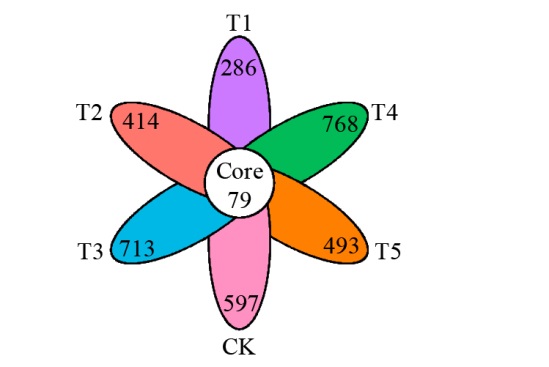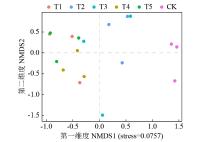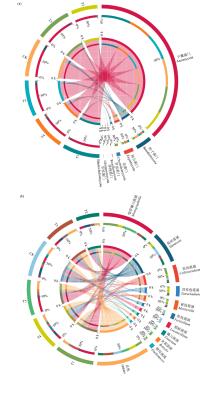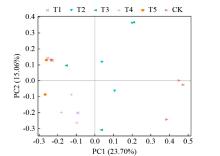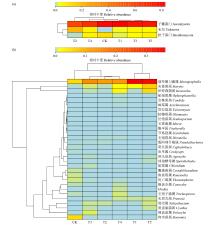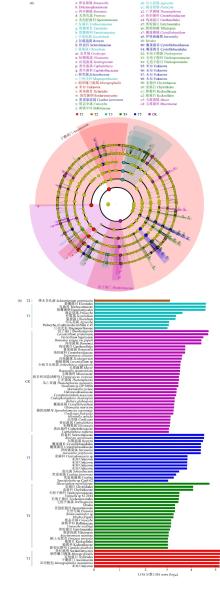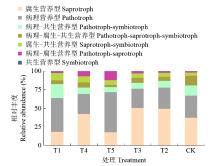作物杂志,2025, 第5期: 221–232 doi: 10.16035/j.issn.1001-7283.2025.05.029
不同轮作模式对高寒黑土区马铃薯根际土壤真菌群落结构与功能的影响
王籽懿1( ), 韩伟2, 金鸿飚3, 黄修梅1(
), 韩伟2, 金鸿飚3, 黄修梅1( ), 张凤兰4, 杨忠仁4
), 张凤兰4, 杨忠仁4
- 1
内蒙古农业大学职业技术学院 014109, 内蒙古包头
2雪川农业集团股份有限公司 075000, 河北张家口
3呼伦贝尔市农牧科学研究所 021000, 内蒙古呼伦贝尔
4内蒙古农业大学园艺与植物保护学院 010000, 内蒙古呼和浩特
The Effects of Different Rotation Patterns on the Structure and Function of Fungal Communities in Potato Rhizosphere Soil in High-Altitude Black Soil Areas
Wang Ziyi1( ), Han Wei2, Jin Hongbiao3, Huang Xiumei1(
), Han Wei2, Jin Hongbiao3, Huang Xiumei1( ), Zhang Fenglan4, Yang Zhongren4
), Zhang Fenglan4, Yang Zhongren4
- 1
Vocational and Technical College of Inner Mongolia Agricultural University ,Baotou 014109 Inner Mongolia, China
2Xuechuan Agricultural Group Co. ,Ltd., Zhangjiakou 075000 Hebei, China
3Hulun Buir Agricultural and Animal Husbandry Science Research Institute ,Hulun Buir 021000 Inner Mongolia, China
4College of Horticulture and Plant Protection of Inner Mongolia Agricultural University ,Hohhot 010000 Inner Mongolia, China
摘要:
为明确马铃薯不同轮作模式下的根际土壤真菌群落差异,采用真菌ITS区的Illumina NovaSeq 6000高通量测序技术,通过FUNGuild真菌功能预测工具,对比分析当地6种传统种植模式对土壤真菌群落结构和功能的影响。结果表明,6个处理中的土壤样本共获得3350个ASV,划分为7门、22纲、72目、146科、300属和598种;与CK相比,T3、T4处理会提高土壤真菌多样性和丰富度,其中T4处理根际土壤真菌多样性和丰富度最高;不同轮作模式土壤真菌群落门水平的结构组成相似,但相对丰度各异,均以子囊菌门(Ascomycota)为优势菌门,相对丰度为58.60%~82.66%;PCoA分析发现,PC1和PC2可以解释38.76%的群落组成差异;由LEfSe的LDA(阈值为4.0)结果可知,在真菌群落所有分类水平上发现了24个差异物种;通过FUNGuild功能比对发现,不同处理间的主要营养类型为病理营养型和腐生营养型,其相对丰度存在差异,T2、T3及T4处理以腐生营养型为主,其中T3处理相对丰度最高,而T1和T5处理以病理营养型为主,CK则以腐生营养型为主,病理营养型为辅。综上,不同轮作模式改变了土壤真菌群落结构、多样性及营养类型,可用于调控集约化种植的土壤微生态环境,促进高寒黑土区土壤生态系统健康发展,提高粮食产量。
| [1] | Bardgett R D, Putten W H V D. Belowground biodiversity and ecosystem functioning. Nature, 2014, 515(7528):505-511. |
| [2] | Marcel G A V D H, Cameron W. Soil microbial diversity and agro-ecosystem functioning. Plant and Soil, 2013, 363(1/2):1-5. |
| [3] | Cameron W, Franz S B, Franco W, et al. Soil biodiversity and soil community composition determine ecosystem multifunctionality. Proceedings of the National Academy of Sciences of the United States of America, 2014, 111(14):5266-5270. |
| [4] |
Teresa D, Angela D M P A. Accounting for soil biotic effects on soil health and crop productivity in the design of crop rotations. Journal of the Science of Food and Agriculture, 2015, 95(3):447-454.
doi: 10.1002/jsfa.6565 pmid: 24408021 |
| [5] | Venter S Z, Jacobs K, Hawkins H. The impact of crop rotation on soil microbial diversity: a meta-analysis. Pedobiologia-Journal of Soil Ecology, 2016, 59(4):215-223. |
| [6] | D’Acunto L, Andrade F J, Poggio L S, et al. Diversifying crop rotation increased metabolic soil diversity and activity of the microbial community. Agriculture Ecosystems & Environment, 2018, 257:159-164. |
| [7] | Jacoby R, Peukert M, Succurro A, et al. The role of soil microorganisms in plant mineral nutrition—current knowledge and future directions. Frontiers in Plant Science, 2017, 19(8):1617. |
| [8] | Kwak M J, Kong H G, Choi K, et al. Rhizosphere microbiome structure alters to enable wilt resistance in tomato. Nature Biotechnology, 2018, 36(11):1117. |
| [9] | 靳海洋, 岳俊芹, 闫雅倩, 等. 小麦与不同作物多样化轮作对土壤真菌群落的影响. 环境科学, 2022, 43(6):3338-3347. |
| [10] | 南镇武, 刘柱, 孟维伟, 等. 黄河下游冲积平原轮作休耕农田土壤真菌群落结构与功能. 环境科学, 2023, 44(1):482-493. |
| [11] | Tedersoo L, Bahram M, Põlme S, et al. Global diversity and geography of soil fungi. Science, 2014, 346(6213):1256688. |
| [12] | 郭金瑞, 宋振伟, 彭宪现, 等. 东北黑土区长期不同种植模式下土壤碳氮特征评价. 农业工程学报, 2015, 31(6):178-185. |
| [13] |
杜国明, 张瑞, 于凤荣. 基于地学信息图谱的东北黑土区种植模式分析. 应用生态学报, 2022, 33(3):694-702.
doi: 10.13287/j.1001-9332.202203.017 |
| [14] | 蔡祖聪. 浅谈“十四五”土壤肥力与土壤养分循环分支学科发展战略. 土壤学报, 2020, 57(5):1128-1136. |
| [15] | Clélia S, Nicolas G, Bosem A B, et al. Increasing crop heterogeneity enhances multitrophic diversity across agricultural regions. Proceedings of the National Academy of Sciences of the United States of America, 2019, 116(33):16442-16447. |
| [16] | Delphine R, David T. National food production stabilized by crop diversity. Nature, 2019, 571(7764):257-260. |
| [17] |
Tiemann L K, Grandy A S, Atkinson E E, et al. Crop rotational diversity enhances belowground communities and functions in an agroecosystem. Ecology Letters, 2015, 18(8):761-771.
doi: 10.1111/ele.12453 pmid: 26011743 |
| [18] | Tony Y, Newton L, Arnaud S M, et al. Anthropogenic drivers of soil microbial communities and impacts on soil biological functions in agroecosystems. Global Ecology and Conservation, 2021, 27:e01521. |
| [19] | McDaniel M D, Grandy A S, Tiemann L K, et al. Crop rotation complexity regulates the decomposition of high and low quality residues. Soil Biology and Biochemistry, 2014, 78:243-254. |
| [20] | Davis S A, Hill D J, Chase A C, et al. Increasing cropping system diversity balances productivity, profitability and environmental health, PLoS ONE, 2017, 7(10):e47149. |
| [21] | Benitez M S, Ewing P M, Osborne S L, et al. Rhizosphere microbial communities explain positive effects of diverse crop rotations on maize and soybean performance. Soil Biology and Biochemistry, 2021, 159:108359. |
| [22] |
Lalitha G, Christina M S, Cau D P, et al. Detection of fungal DNA in human body fluids and tissues during a multistate outbreak of fungal meningitis and other infections. Eukaryotic Cell, 2013, 12(5):677-683.
doi: 10.1128/EC.00046-13 pmid: 23457192 |
| [23] | Bender F S, Wagg C, Heijden D V G M. An Underground Revolution: Biodiversity and Soil Ecological Engineering for Agricultural Sustainability. Trends in Ecology & Evolution, 2016, 31(6):440-452. |
| [24] | Fadiji E A, Kanu O J, Babalola O O. Metagenomic profiling of rhizosphere microbial community structure and diversity associated with maize plant as affected by cropping systems. International Microbiology, 2021, 24(3):1-11. |
| [25] | Brussaard L, Ruiter D C P, Brown G G. Soil biodiversity for agricultural sustainability. Agriculture Ecosystems & Environment, 2006, 121(3):233-244. |
| [26] | 胡元森, 刘亚峰, 吴坤, 等. 黄瓜连作土壤微生物区系变化研究. 土壤通报, 2006, 37(1):126-129. |
| [27] | 黄修梅, 李明, 戎素萍, 等. 生物炭添加对马铃薯根际土壤真菌多样性和产量的影响. 中国蔬菜, 2019(1):51-56. |
| [28] | 张瑞平, 苟小梅, 张毅, 等. 生物有机肥与化肥配施对植烟土壤养分和真菌群落特征的影响. 西北农林科技大学学报(自然科学版), 2020, 48(8):85-92. |
| [29] | 孙倩, 吴宏亮, 陈阜, 等. 不同轮作模式下作物根际土壤养分及真菌群落组成特征. 环境科学, 2020, 41(10):4682-4689. |
| [30] | 刘星, 邱慧珍, 王蒂, 等. 甘肃省中部沿黄灌区轮作和连作马铃薯根际土壤真菌群落的结构性差异评估. 生态学报, 2015, 35(12):3938-3948. |
| [31] | 牛倩云, 韩彦莎, 徐丽霞, 等. 作物轮作对谷田土壤理化性质及谷子根际土壤细菌群落的影响. 农业环境科学学报, 2018, 37(12):2802-2809. |
| [32] |
Gabriele B, Kornelia S. Plant species and soil type cooperatively shape the structure and function of microbial communities in the rhizosphere. FEMS Microbiology Ecology, 2009, 68(1):1-13.
doi: 10.1111/j.1574-6941.2009.00654.x pmid: 19243436 |
| [33] | Kaile Z, Gabriel M, Liao H L. How soil biota regulate C cycling and soil C pools in diversified crop rotations. Soil Biology & Biochemistry, 2021, 156:108219. |
| [34] | 任益, 刘鸿雁, 吴龙华, 等. 黔西北土壤重金属高背景区晚疫病马铃薯根际土壤真菌群落特征. 生态学杂志, 2023, 42(9):2148-2155. |
| [35] | Wen X Y, Dubinsky E, Wu Y, et al. Wheat,maize and sunflower cropping systems selectively influence bacteria community structure and diversity in their and succeeding crop's rhizosphere. Journal of Integrative Agriculture, 2016, 15(8):1892-1902. |
| [36] |
Li S, Wu F Z. Diversity and co-occurrence patterns of soil bacterial and fungal communities in seven intercropping systems. Frontiers in Microbiology, 2018, 9:1521.
doi: 10.3389/fmicb.2018.01521 pmid: 30034385 |
| [37] | 阳祥, 黄晓婷, 王纯, 等. 典型稻田土壤真菌群落结构及多样性对比. 中国环境科学, 2020, 40(10):4549-4556. |
| [38] |
Schoch C L, Gi-Ho S, Francesc L, et al. The Ascomycota tree of life: a phylum-wide phylogeny clarifies the origin and evolution of fundamental reproductive and ecological traits. Systematic Biology, 2009, 58(2):224-239.
doi: 10.1093/sysbio/syp020 pmid: 20525580 |
| [39] | 郭童鑫, 姚晓华, 吴昆仑, 等. 不同施肥水平对青稞豌豆混作根际土壤真菌群落结构及多样性的影响. 土壤, 2023, 55(6):1261-1271. |
| [40] | 宋佳承. 轮作及连作对马铃薯生长发育及根际微环境的影响. 兰州: 甘肃农业大学, 2020. |
| [41] |
Beimforde C, Feldberg K, Nylinder S, et al. Estimating the phanerozoic history of the Ascomycota lineages: combining fossil and molecular data. Molecular Phylogenetics and Evolution, 2014, 78:386-398.
doi: 10.1016/j.ympev.2014.04.024 pmid: 24792086 |
| [42] | Viaud M, Pasquier A, Brygoo Y. Diversity of soil fungi studied by PCR-RFLP of ITS. Mycological Research, 2000, 104(9):1027-1032. |
| [43] | 韩继刚, 骆玉珍, 张维维. 上海典型城市生态廊道的土壤真菌多样性. 园林, 2024, 41(4):34-41. |
| [44] |
陈媛, 李金阳, 张宇宏, 等. 一株特异腐质霉纤维素酶高产突变株的鉴定分析. 生物技术进展, 2019, 9(2):185-190.
doi: 10.19586/j.2095-2341.2019.0012 |
| [45] | 巫瑞, 袁美静, 康晓玲, 等. 月季炭疽病内生拮抗细菌的筛选鉴定及抑菌作用. 南方农业学报, 2024, 55(4):1046-1059. |
| [46] | Zhang H S, Wu X H, Li G, et al. Interactions between arbuscular mycorrhizal fungi and phosphate-solubilizing fungus (Mortierella sp.) and their effects on Kostelelzkya virginica growth and enzyme activities of rhizosphere and bulk soils at different salinities. Biology and Fertility of Soils, 2011, 47(5):543-544. |
| [47] | Nicosia M G L D, Mosca S, Mercurio R, et al. Dieback of Pinus nigra seedlings caused by a strain of Trichoderma viride. Plant disease, 2015, 99(1):44-49. |
| [48] | 纳小凡, 郑国旗, 邢正操, 等. 连作对再植枸杞根际细菌群落多样性和群落结构的影响. 土壤学报, 2017, 54(5):1280-1292. |
| [1] | 张海斌,蒙美莲,刘坤雨,章凌翔,陈有君. 不同轮作模式对马铃薯干物质积累、病害发生及产量的影响[J]. 作物杂志, 2019, (4): 170–175 |
| [2] | 向德明,张明发,彭曙光,田峰,罗建新,陈武,蔡云帆,田明慧,吕启松. 连年施用新型肥料对土壤真菌群落及烤烟产质量的影响[J]. 作物杂志, 2019, (2): 156–163 |
|
||



